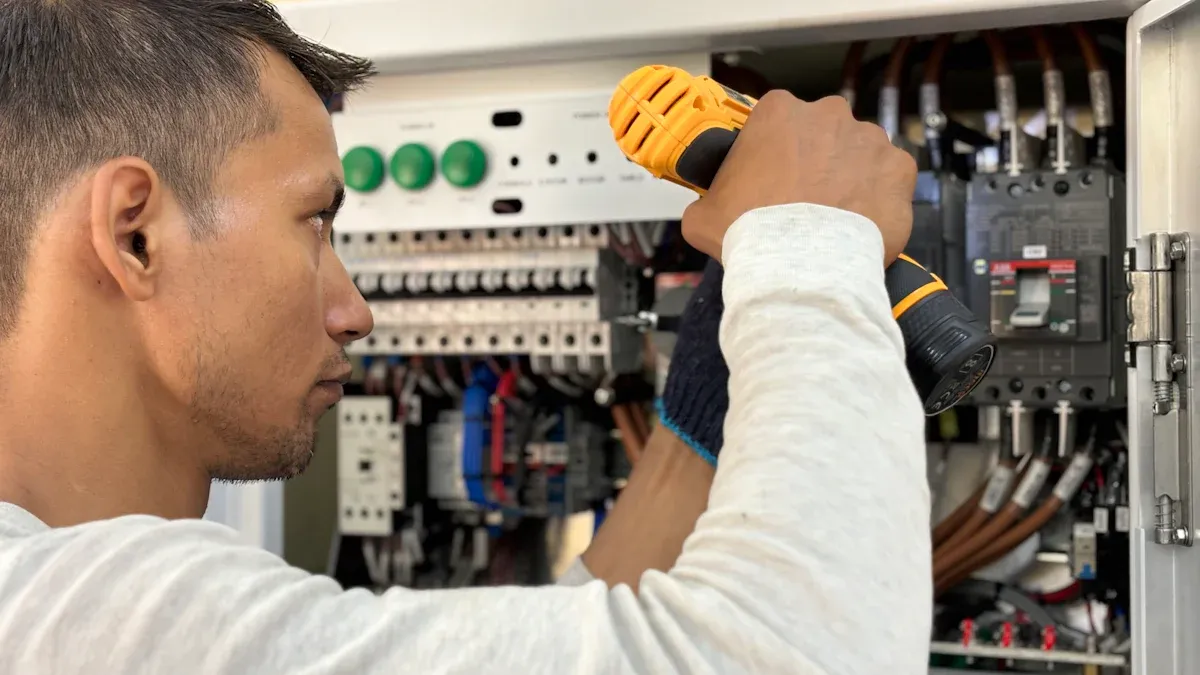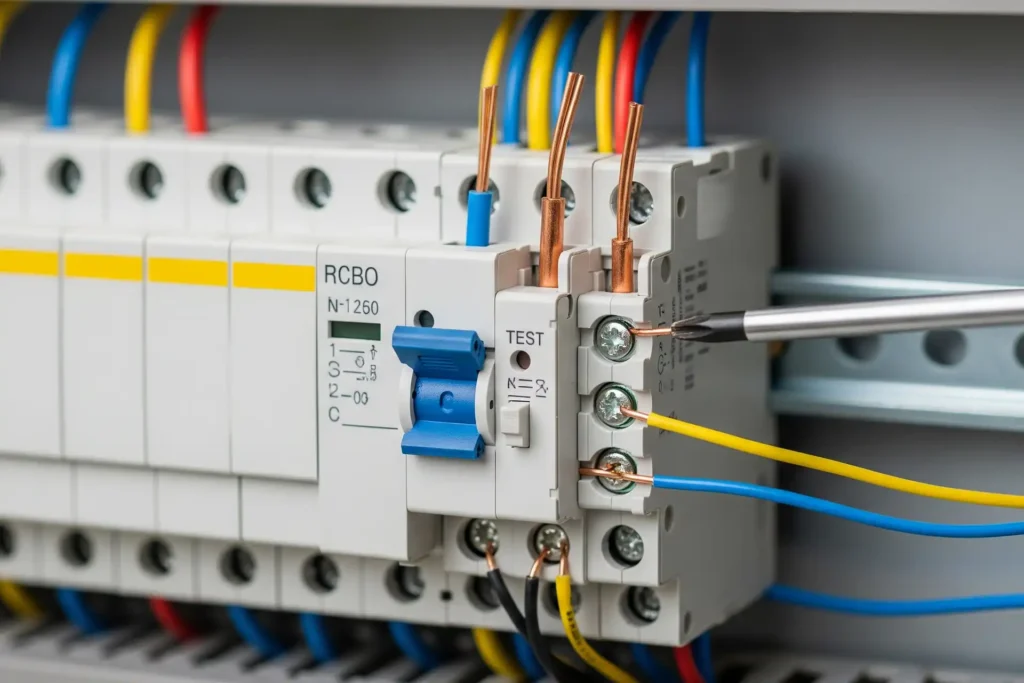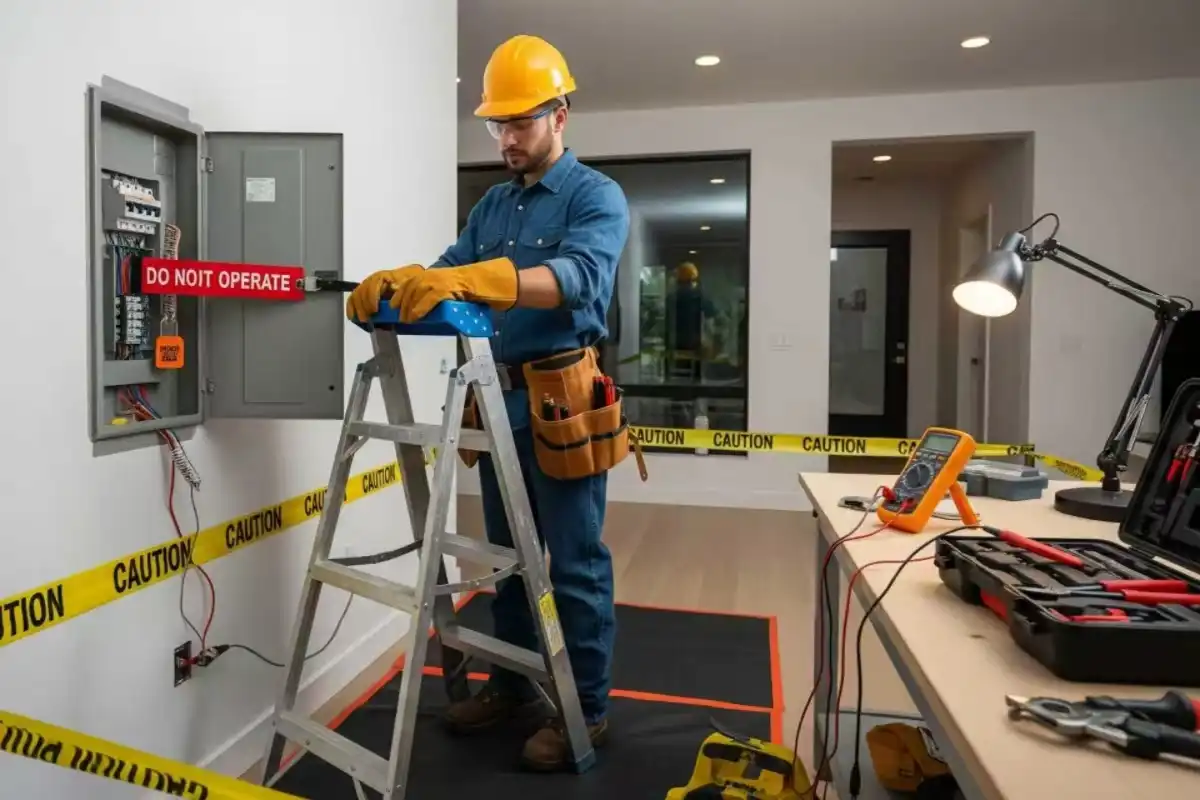You need to connect RCBO in the distribution panel carefully to ensure your home stays safe. Using the correct wiring when you connect RCBO in the distribution panel helps prevent loose connections, which can lead to overheating or fires. Always turn off the power before you begin the process. Choose the right tools and wear safety gear to protect yourself from injury. Mistakes with electricity, such as overloads, short circuits, or improper setup, can be dangerous. If you are unsure about how to connect RCBO in the distribution panel, it’s best to consult a licensed electrician for assistance.
Key Takeaways
- Always switch off the main power before you start. Use a voltage tester to check wires. This helps keep you safe.
- RCBOs help protect people and wires. They shut off power fast if there is too much current, a short circuit, or an earth fault. They combine two safety devices in one.
- Follow each wiring step with care. Connect live and neutral wires to the correct terminals. Never mix neutral wires with earth wires after the RCBO.
- Use the right tools and wear safety gear. Insulated screwdrivers, gloves, and safety glasses help stop injuries when working on panels.
- Test your RCBO every month with its test button. This makes sure it works right. Call a licensed electrician if it keeps tripping or if you are not sure what to do.
RCBO Basics
What Is an RCBO
You might ask what an RCBO does in your panel. An RCBO is a safety device with two main jobs. It keeps you safe from electric shocks by finding earth fault currents. These are also called leakage currents. It also protects wires and devices from too much current. This includes overloads and short circuits. If the RCBO finds a problem, it shuts off the power fast. This helps stop injuries, fires, and damage to your things.
You get both kinds of protection in one small device. The RCBO checks if the live and neutral wires match. If there is a difference or too much current, it trips and stops the electricity. This makes your home or business safer. You save space in your panel and make setup easier. You do not need separate devices for each type of protection.
Tip: RCBOs work great in homes, offices, and factories. They help you follow safety rules and keep your system working well.
RCBO vs. MCB and RCD
You may see other devices in your panel like MCBs and RCDs. Each one does something different. The table below shows how they are not the same:
| Feature | MCB (Miniature Circuit Breaker) | RCD (Residual Current Device) | RCBO (Residual Current Breaker with Overcurrent) |
|---|---|---|---|
| Protection Type | Overload, short circuit | Earth leakage, electric shock | Overload, short circuit, earth leakage |
| Operation Mechanism | Thermal/magnetic trip | Detects leakage with transformer | Combines both mechanisms |
| Circuit Coverage | Individual circuit | Multiple circuits | Individual circuit |
| Trip Behavior | Trips on overload/short circuit | Trips on earth leakage | Trips only faulty circuit |
| Installation & Space | One per circuit | One for several circuits | One per circuit, saves space |
| Safety Focus | Protects wiring and devices | Protects people | Protects both people and wiring |
| Cost & Efficiency | Lower cost, limited protection | Lower cost, less coverage | Higher cost, full protection |
When you use an RCBO, you get the good parts of both an MCB and an RCD in one device. This means each circuit is safe from all big electrical problems. Your panel is less crowded and easier to use. RCBOs cost more at first, but they help you avoid bigger trouble and costs later.
Safety Precautions
Power Off Procedures
You need to be safe before you work on the panel. Always turn off the main power first. This keeps you safe from electric shock. Follow these steps to turn off the panel:
- Turn off the main breaker to stop all power.
- Take off the panel cover by unscrewing it slowly.
- Find the circuit where you will put the RCBO.
- Use a voltage tester to make sure no wires are live. Do not just look—always test the wires.
- Check the feeder wires for cracks or worn spots. Change any wires that look damaged.
- Follow all safety rules for grounding and wiring.
- When you finish, put the panel cover back on tight.
- Turn the main power back on and test the RCBO.
⚠️ Tip: Treat every wire as if it is live unless you locked and tagged the power. Never skip the voltage test.
Tools and PPE
You need the right tools and PPE to stay safe. Good gear helps stop injuries from shocks or flying pieces. Here is what you should have:
- Insulated screwdrivers and pliers
- Voltage tester or multimeter
- Safety glasses for your eyes
- Electrical gloves for the right voltage
- Flame-resistant clothes
- Grounding straps
- Lockout/tagout tools to keep power off
Check your workspace before you start. Make sure it is dry and not messy. Keep a clear path to get out fast if needed. Look at the panel for rust, corrosion, or hot spots. If you feel tingling, shocks, or hear odd sounds, stop working. Only trained people should touch live parts. Always use safe work steps.
🛡️ Note: The rules say you must use PPE and lockout/tagout steps. These help stop shocks and keep your area safe.
Connect RCBO in the Distribution Panel

Identify Terminals
When you connect RCBO in the distribution panel, you need to find the right terminals first. Look at the RCBO device. You will see markings for Line (L) and Neutral (N). The Line terminal is for the live wire. The Neutral terminal is for the neutral wire. Some RCBOs have extra wires, like a blue or white cable. These may connect to the main neutral block or the earth bar. Always check the manufacturer’s label or diagram. This helps you avoid mistakes and keeps your wiring safe.
Tip: If you see a white reference cable, connect it to the earth bar. This cable helps the RCBO monitor voltage and gives extra protection if the neutral is lost.
Wiring Steps
You must follow each step carefully when you connect RCBO in the distribution panel. Here is a simple guide:
- Turn off the main power before you start.
- Find the input terminals on the RCBO. Connect the incoming live wire to the Line terminal. Connect the incoming neutral wire to the Neutral terminal.
- If your RCBO has a blue or white wire, connect the blue wire to the main neutral block. Connect the white wire to the earth bar.
- Find the output terminals. Connect the outgoing live and neutral wires to the load circuit, such as lights or outlets.
- Make sure the earth wire from the load goes to the earth terminal in the panel.
- Double-check that the neutral wire passes through the RCBO’s neutral terminal. This step is very important. The RCBO needs both live and neutral wires for accurate current measurement. If you skip this, the RCBO may not trip during a fault.
- Use the right wire size for your load. For most homes, #10 or #12 gauge wire works well. Check the manufacturer’s table for bigger loads.
- After wiring, test the RCBO to make sure it works.
⚡ Alert: Never connect the neutral wire to the earth wire downstream of the RCBO. This mistake causes false trips and makes your system unsafe.
Single-Phase and Three-Phase
You need to know your system type before you connect RCBO in the distribution panel. In single-phase systems, you use a 1-pole RCBO. Connect one live wire and one neutral wire. For two-pole RCBOs, connect both the live and neutral wires from the supply to the input terminals, then connect the output terminals to the load.
In three-phase systems, you use a 3-pole plus neutral RCBO. Connect the three live wires (L1, L2, L3) and the neutral wire to the RCBO’s input terminals. Connect the output terminals to the load, such as a spa or motor. Always connect the ground wire to the load’s earth terminal. Use the right RCBO type for your system. The number of poles must match the number of phases.
Note: In split load consumer units, RCBOs have built-in neutral and earth wires. Connect the RCBO’s neutral wire directly to the main neutral block. Connect the functional earth wire to the main earth bar. This setup gives each circuit its own protection and makes wiring easier.
Secure Connections
You want every connection to be tight and safe when you connect RCBO in the distribution panel. Use terminals that fit your wire size. Bigger terminals help you make strong connections and save space. Make sure each wire sits firmly in its terminal. Loose wires can cause overheating or sparks.
Choose RCBOs with advanced features, like anti-arc spray technology and instant make-and-break action. These features help the RCBO work better and last longer. Check that your RCBO fits well in the panel. The device should handle high temperatures and tough conditions.
After you finish, inspect every connection. Tug each wire gently to check if it stays in place. Look for signs of damage or corrosion. If you see any problems, fix them before you turn the power back on.
🛡️ Tip: Always follow the manufacturer’s instructions and local codes. If you feel unsure, ask a licensed electrician for help.
Test RCBO Function
Initial Testing
After you finish wiring, you need to test the RCBO to make sure it works safely. Follow these steps for a proper check:
- Move the RCBO handle up and down. Make sure it moves smoothly and clicks into place.
- Check every wire. Look for loose connections or exposed copper. Tighten any loose screws.
- Turn the main power back on. Use a multimeter to measure voltage at the RCBO terminals. You should see about 230 volts between the line and neutral on the incoming side. The outgoing side should show a low voltage (below 20V) when the RCBO is open.
- Flip the RCBO to the ON position. Test the voltage again to confirm power flows to the load.
- Press the test button on the RCBO. This simulates a ground fault. The RCBO should trip immediately and cut power.
⚡ Tip: Always use the test button every month. This keeps your RCBO working and protects your home.
Troubleshooting
Sometimes, the RCBO may trip or not work as expected. Here are common issues and how you can fix them:
- If the RCBO trips only when a load is on, check for a neutral-to-earth fault in your wiring.
- Make sure the neutral wire from the load connects to the RCBO, not the main neutral bar. Crossed or borrowed neutrals cause false trips.
- If the RCBO still trips, try replacing it with another one. Sometimes, the device itself is faulty.
- Break the circuit into smaller parts. Test each section to find where the problem is.
- Double-check all neutral and earth connections. Use an insulation resistance tester to check for hidden faults.
🛠️ Note: Many RCBO failures come from wiring mistakes or damaged cables. Careful checks help you find the real problem.
When to Call an Electrician
You should call a licensed electrician if:
- The RCBO trips even after you check all wiring.
- You find signs of burning, corrosion, or water damage in the panel.
- You do not feel confident using a multimeter or insulation tester.
- Your home has many electronic devices, which can cause nuisance tripping from earth leakage or harmonics.
- You need to install RCBOs in harsh or unusual environments.
🧑🔧 Tip: Electricians have special tools and training. They can spot hidden problems and make sure your system meets safety codes.
You keep your home and family safe by connecting RCBO in the distribution panel carefully. Every step helps stop electric shocks, fires, and wiring errors. Testing the RCBO after you install it makes sure it works right. If you are not sure or see trouble, call a licensed electrician.
- RCBOs shut off circuits fast when there is a problem, so you stay safe.
- Check your panel every year and test emergency systems each month to find problems early.
- You need to upgrade if your panel is old, too full, or does not meet safety rules.
Follow these steps to stay safe and keep your electrical system working well.
FAQ
What should you do if your RCBO keeps tripping?
You should check for faulty appliances or wiring on the circuit. Unplug everything and reset the RCBO. Plug in devices one by one to find the problem. If the RCBO still trips, call a licensed electrician.
Can you install an RCBO in any distribution panel?
You can install an RCBO in most modern panels. Always check the panel’s size and type. Make sure the RCBO fits and matches your system. Read the manufacturer’s instructions before you start.
Why does the RCBO need its own neutral wire?
The RCBO measures current in both the live and neutral wires. If you do not connect the neutral wire to the RCBO, it cannot detect earth faults. This makes the protection fail.
How often should you test your RCBO?
You should press the test button on your RCBO every month. This checks that the safety feature works. Mark your calendar or set a reminder so you do not forget.
What tools do you need to connect an RCBO safely?
You need insulated screwdrivers, a voltage tester, safety gloves, and safety glasses. Always use tools rated for electrical work. A clear workspace helps you stay safe.
🛡️ Tip: Always turn off the main power before you start any electrical work.
See also
Understanding RCBO Breaker Terminology Made Simple
RCBO residual current circuit breaker with overcurrent protection
What Features Make an RCBO Essential for Modern EV Charger Setups
Key Differences Between RCD, MCB, and ROCO Devices
RCBO and RCCB Explained for Beginners




